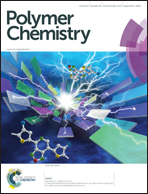Chalcogenodiazolo[3,4-c]pyridine based donor–acceptor–donor polymers for green and near-infrared electrochromics†
Abstract
A series of thiadiazolo[3,4-c]pyridine (PT)/selenadiazolo[3,4-c]pyridine (PSe) in alternation with a variety of thiophenes including thiophene (Th), 3-methylthiophene (MeTh), 3-hexylthiophene (HexTh) and 3,4-ethoxylenedioxythiophene (EDOT) based donor–acceptor–donor (D–A–D) monomers were designed and electropolymerized to yield their corresponding polymers. The structure–property relationships of these monomers/polymers, including band gap, electrochemical behavior, and optical properties, were comparatively investigated. The monomers exhibited orange, red, and purple emission characteristics with quantum yields ranging from 0.072 to 0.849 and could probably be used as building blocks for rational design of fluorescent materials. Also, it was noted that these donor and acceptor units played key roles in optical absorption, leading to neutral electrochromic polymers with different colors including green, purple, gray, sky blue and dark blue. In particular, the obtained EDOT based polymers revealed an obvious color change from green to blue with a faster response time (0.3–0.6 s) relative to their benzochalcogenodiazole analogues. Furthermore, the thiophene and alkyl thiophene-based polymers kept their color constant under different applied voltages and showed superior optical contrast (∼37%) in the near-infrared region compared with that in the visible region. These intriguing features of polymeric materials demonstrated that insertion of chalcogenodiazolo[3,4-c]pyridine into a D–A–D system allowed the formation of green and near-infrared electrochromes.
![Graphical abstract: Chalcogenodiazolo[3,4-c]pyridine based donor–acceptor–donor polymers for green and near-infrared electrochromics](/en/Image/Get?imageInfo.ImageType=GA&imageInfo.ImageIdentifier.ManuscriptID=C5PY01321F&imageInfo.ImageIdentifier.Year=2015)

 Please wait while we load your content...
Please wait while we load your content...